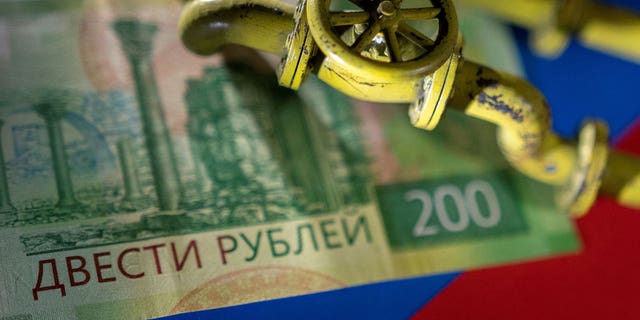close 
Fox News Flash top headlines for January 16
Fox News Flash top headlines are here. Check out what’s clicking on Foxnews.com.
Russia’s attempts to plug its budget deficit by selling foreign currency reserves could lead to a vicious circle that pushes the ruble higher and further reduces the Kremlin’s crucial export revenues, analysts say.
Russia’s finance ministry and central bank said last week they would restart interventions in foreign exchange markets for the first time in almost a year, selling 54.5 billion rubles worth of yuan ($793 million) from the National Welfare Fund. The sales started on Jan. 13 and will run for three weeks.
Russia has been using the rainy-day fund, which stood at $186.5 billion as of Dec. 1, to finance its widening budget deficit and stabilise the economy in the face of increasingly tough Western sanctions on Russian energy sales.
RUSSIA THREATENS TO SEIZE PROPERTY FROM BUSINESSES IN OCCUPIED UKRAINE THAT REFUSE TO USE RUBLE
The Kremlin relies on export taxes from hydrocarbon sales to fund its domestic spending, which has increased sharply to cover accelerating costs for the Ukraine war, now in its 11th month.
But analysts say foreign currency sales will push the Russian ruble higher, thus further reducing Russia’s income in rubles since revenues from oil and gas exports are largely based on global benchmark prices that are traded in dollars.
That process could trigger a cycle of weaker export revenues, requiring more foreign currency sales and leading to an even stronger ruble, exacerbating the budget hole.
Vasily Karpunin, an analyst at BCS Express, says there is a risk Russia’s revenue from energy exports will dip even further in February and March, after the next stage of the G7’s price cap – on petroleum products – kicks in on Feb. 5.
The revenue gap could be 2-3 times higher than the 54.5-billion ruble shortfall in January, CentroCreditBank economist Evgeny Suvorov estimates.
“This will require an increase in foreign currency sales, and through exchange rate dynamics (strengthening of the ruble) that may further worsen actual oil and gas revenues,” Rosbank analysts wrote in a recent research note.
The ruble has gained more than 4% against the U.S. dollar since the plan was announced, and was trading at around 68 per dollar on Monday.
GERMANY: G7 REJECTS RUSSIA’S DEMAND TO PAY FOR GAS IN RUBLES

Strategic moves by Russia to address its budget deficit may inadvertently devalue the ruble, analysts warn.
(REUTERS/Dado Ruvic/Illustration/File Photo)
Budget Hole
Russia posted a 3.3 trillion ruble deficit in 2022, equivalent to 2.3% of GDP – one of its worst performances since President Vladimir Putin came to power over two decades ago.
Finance minister Anton Siluanov said in December that the price cap imposed on its oil could mean Russia’s budget deficit is wider than current plans for 2% of GDP in 2023. Government officials have also publicly said they would like to see a weaker ruble – something the foreign currency interventions seem likely to prevent.
Analysts at Alfa Bank said it was “puzzling” the finance ministry would restart FX sales while the Kremlin is also aiming for a weaker ruble.
Russia’s budget for this year is based on a Urals blend price of around $70.10 a barrel, though Russia’s main blend is currently trading at around $50 a barrel.
In rubles, that is a two-year low, according to Reuters calculations.
“If the relatively low prices for Urals last for a long time, and the ruble remains relatively strong, then the budget hole will inflate,” said Anton Tabakh, Chief Economist of RA Expert.
CLICK HERE TO GET THE FOX NEWS APP
State-owned bank Sberbank estimates that if the average price for Russia’s Urals blend was $55 per barrel, and the ruble continued trading around 67 against the U.S. dollar, the government will be required to sell $1.5 billion — or 100 billion rubles — of foreign exchange holdings every month to cover the gap.
